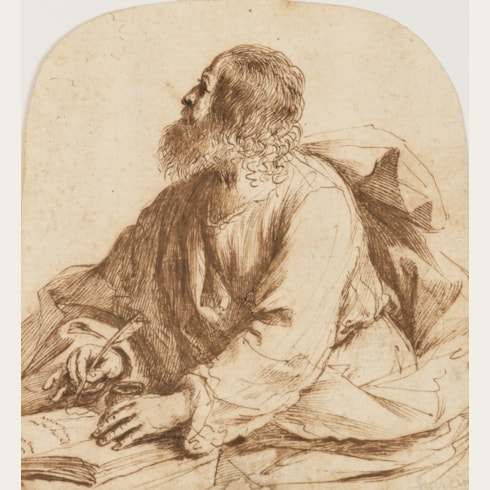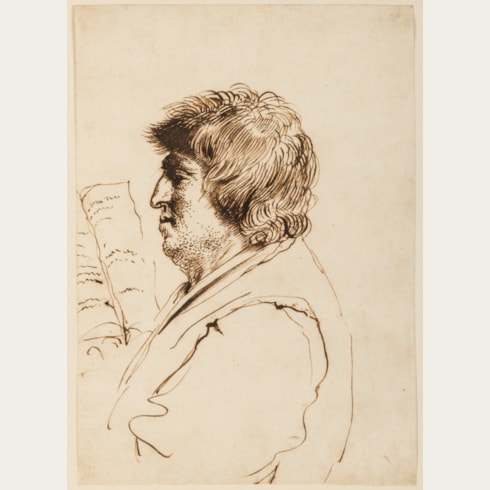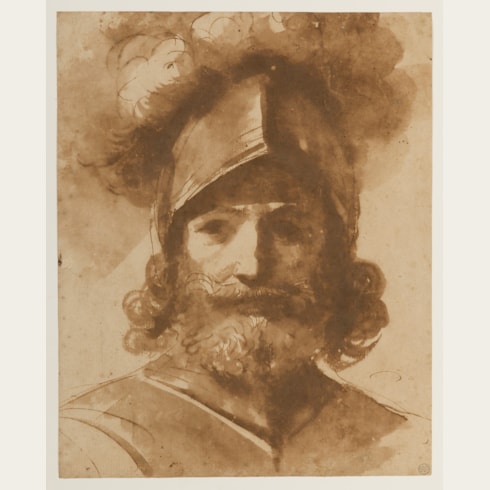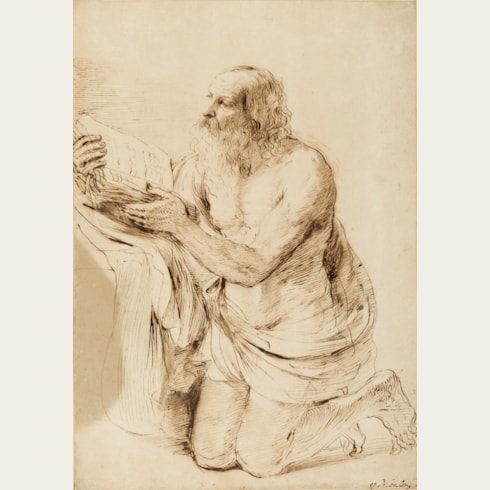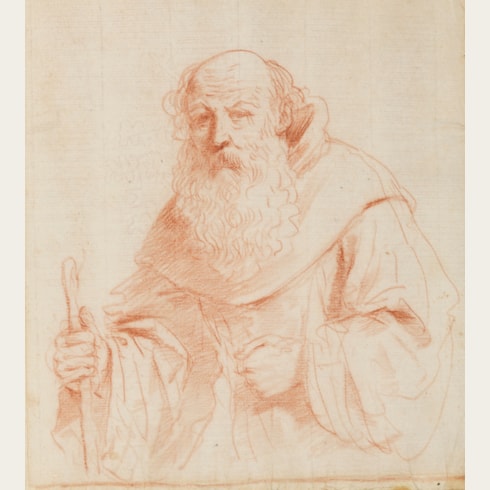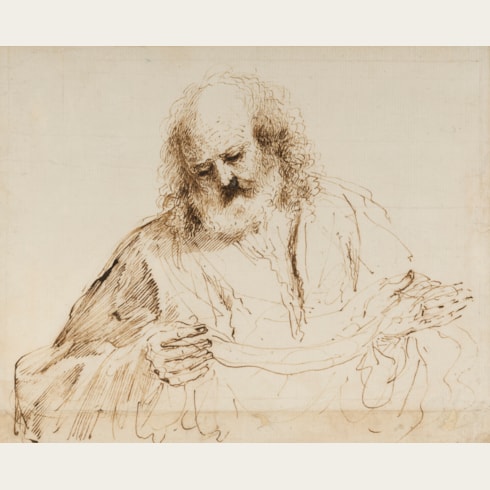Giovanni Francesco Barbieri GUERCINO
(Cento 1591 - Bologna 1666)
A Kneeling Male Nude
Inscribed (by Dubini) with the sheet size '555/775 'in pencil at the lower right.
Further inscribed 'questo disegno del Guercino / fu Di Bastiano Ricci / [?] volta(?)di Jacopo Parolini / Pittore ferrarese donatogli in Bologna dall’ A[?] per memoria' on the verso, partly backed.
559 x 379 mm. (22 x 14 7/8 in.)
As one scholar has noted, ‘Guercino’s many drawings of seated, kneeling, or reclining nude or draped youths done in black chalk or charcoal on coarse, tinted papers, [were] made in the studio in the years prior to the painter’s Roman sojourn. These unusually large-scale studies were drawn by the master as exemplae for students, teaching them how to draw forms in contrasting light and shadow from a living model…Guercino’s pre-Roman life drawings generally represent nude figures and often show the same model in various attitudes, accompanied by simple props such as staffs, draperies, and blocks to sit upon.’ It has been suggested that Guercino’s charcoal ‘nudi d’accademia’ of this type were drawn on a large-scale so that they could more easily be seen by all of the pupils working in a large studio. Referring to the technique of these early drawings by the artist, John Marciari has opined that ‘the chalk or charcoal dipped in gum solution perhaps appealed to Guercino because the intense, bold effect it created corresponded to the forthright study that underlay the drawings’ conception, something different from the furious sketching of his pen drawings or the refinement of a more delicate chalk study.’ After about 1620, however, drawings of this type largely disappear from Guercino’s oeuvre, as he found himself too busy with commissions to continue his work at the Accademia del Nudo.
Drawn on faded blue-grey paper, the present sheet may likely be dated to around 1618, the year in which Guercino spent some time in Venice, where he would have become familiar with the use of blue paper by local artists. As Marzia Faietti has pointed out, ‘While it is difficult to provide precise dates for the nude studies of the pre-Roman period since for the most part they were not intended as preliminary to a finished work of art, they often reveal the artist experimenting with poses to be used later in a painting, or they were extrapolated from preparatory studies for paintings.’ It may be noted that the pose of the male nude in this drawing is very similar, albeit with the position of the arms reversed, to that on one side of a comparable large-scale drawing of c.1617-1618 by Guercino; a double-sided study of David with the Head of Goliath in the Uffizi, drawn in soft black chalk on blue paper. Both sides of the Uffizi drawing are in turn preparatory studies for an independent, portable fresco painting of the same subject, executed around 1618 and now in the Nelson-Atkins Museum of Art in Kansas City, Missouri. The present sheet was probably done at around the same time as the Nelson-Atkins fresco - a work which exhibits a pronounced Venetian quality - and may well have been a first idea for the pose of David in the composition. Whether or not this large sheet was drawn specifically as a study for the David with the Head of Goliath, however, cannot easily be determined. As the Guercino scholar David Stone has noted, ‘When it has been possible to relate one of Guercino’s nude studies to a figure depicted in a compositional sketch or a painting, scholars have queried whether the study was made (and the model posed) specifically for the task or whether, as seems to be more likely, it is not simply a case of a ready-made image from a life session being pressed into service at a later date when needed.’
The pose of the male nude in this large drawing shares some affinities with the muscular ignudi-like figures in niches earlier painted by Guercino in monochrome fresco in the Casa Provenzale in Cento in 1614 and still in situ. These were inspired by the Carracci family’s decoration of the Palazzo Fava in Bologna, executed some thirty years beforehand, which Guercino must have studied closely.
Among stylistically comparable charcoal drawings of male nudes by Guercino is a sheet in the Metropolitan Museum of Art in New York and a drawing of A Male Nude Lying on the Ground, of considerable scale but still somewhat smaller than the present sheet, which appeared at auction in 1993 and is today in an American private collection, as well as a large study of a seated young man in the J. Paul Getty Museum in Los Angeles. As Nicholas Turner and Carol Plazzotta have noted of such drawings, ‘Guercino’s studies from the living nude model are masterly in their suggestion of light, their confident handling, and their economic simplification of form.’ Other large-scale life studies of this type by the artist are today in the collections of the Pinacoteca Nazionale in Bologna, the Civica Pinacoteca il Guercino in Cento, the Uffizi in Florence, the Palazzo Rosso in Genoa, the National Gallery of Victoria in Melbourne, the Biblioteca Ambrosiana in Milan, the Pierpont Morgan Library in New York, the Ashmolean Museum in Oxford, the Ecole des Beaux-Arts in Paris, the J. Paul Getty Museum in Los Angeles, the Royal Collection at Windsor Castle, and elsewhere.
According to a contemporary inscription on the verso of the sheet, this drawing was at one time in the possession of two Italian artists of the late Baroque period; the noted Venetian painter Sebastiano Ricci (1659-1734), whose peripatetic career saw him working in Venice, Bologna, Turin, Florence, London and Paris, and the lesser-known Ferrarese artist Giacomo Parolini (1663-1733), who was trained in Bologna but was mainly active in Ferrara, where he painted several altarpieces for local churches. If the inscription is accurate, it seems that this drawing was given by Ricci to Parolini in Bologna as a sign of friendship. As Denis Mahon has pointed out, both Ricci and Parolini studied in Bologna around 1680, in the circle of the local painters Carlo Cignani and Giovan Gioseffo dal Sole, and furthermore Parolini is known to have made a copy of Guercino’s altarpiece of Saint William of Aquitaine Receiving the Monastic Habit, then in the church of San Gregorio in Bologna, that was much praised by Cignani.
The present sheet later entered the collection of the Milanese industrialist Francesco Dubini (1848-1932), who began collecting drawings, with an emphasis on works by Italian artists, at the end of the 19th century, advised by the art historian and critic Gustavo Frizzoni. Dubini is known to have owned a number of drawings by Guercino. While this large sheet does not bear Dubini’s collector’s mark, this is true of several of the drawings in his collection. Instead, the collector often inscribed the dimensions of the work, written in pencil, on the sheet itself, as is the case with this drawing. Although Dubini presented a group of forty-one drawings to the Pinacoteca di Brera in Milan in 1906, the rest of his collection was dispersed several years after his death.
This drawing also belonged to the Italian scholar and art historian Prisco Bagni (1921-1995), a native of Cento who published several important studies on Guercino and his studio, as well as on the Gandolfi family of artists. Bagni lent the present sheet to the important exhibition of Guercino drawings held in Bologna in 1991, on the four hundredth anniversary of the artist’s birth.
Giovanni Francesco Barbieri, known as Il Guercino (‘the squinter’) because he was cross-eyed, was by the second decade of the 17th century one of the leading painters in the province of Emilia. Born in Cento, a small town between Bologna and Ferrara, Guercino was largely self-taught, although his early work was strongly influenced by the paintings of Ludovico Carracci. In 1617 he was summoned to Bologna by Alessandro Ludovisi, the Cardinal Archbishop of Bologna, and there painted a number of important altarpieces, typified by the Saint William Receiving the Monastic Habit, painted in 1620 and now in the Pinacoteca Nazionale in Bologna. When Ludovisi was elected Pope Gregory XV in 1621, Guercino was summoned to Rome to work for the pontiff and his nephew, Cardinal Ludovico Ludovisi. It was in Rome that Guercino painted some of his most celebrated works, notably the ceiling fresco of Aurora in the Casino Ludovisi and the large altarpiece of The Burial and Reception into Heaven of Saint Petronilla for an altar in Saint Peter’s. The papacy of Gregory XV was short-lived, however, and on the death of the Pope in 1623 Guercino returned to his native Cento. He remained working in Cento for twenty years, though he continued to receive commissions from patrons throughout Italy and beyond, and turned down offers of employment at the royal courts in London and Paris. Following the death of Guido Reni in 1642, Guercino moved his studio to Bologna, where he received commissions for religious pictures of the sort that Reni had specialized in, and soon inherited his position as the leading painter in the city.
Guercino was among the most prolific draughtsmen of the 17th century in Italy, and his preferred medium was pen and brown ink, although he also worked in red chalk, black chalk, and charcoal. He appears to have assiduously kept his drawings throughout his long career, and to have only parted with a few of them. Indeed, more drawings by him survive today than by any other Italian artist of the period. On his death in 1666 all of the numerous surviving sheets in his studio passed to his nephews and heirs, the painters Benedetto and Cesare Gennari, known as the ‘Casa Gennari’.
The drawings of Guercino, which include figural and compositional studies, landscapes, caricatures and genre scenes, have always been coveted by later collectors and connoisseurs. Indeed, the 18th century amateur Pierre-Jean Mariette noted of the artist that ‘Ce peintre a outre cela une plume tout-à-faite séduisante’. The largest extant group of drawings by Guercino is today in the Royal Collection at Windsor Castle; these were acquired from the Gennari family by King George III’s librarian, Richard Dalton, between about 1758 and 1764.
Provenance
Giacomo Parolini, Bologna and Ferrara (according to a contemporary inscription on the verso)
Francesco Dubini, Milan
Private collection, Milan in 1991
Prisco Bagni, Bologna
Thence by descent.
Literature
Exhibition
























